This list of national addresses includes speeches by heads of state or heads of government, often broadcast live over various media (usually radio and television) and directed at the general public. These often take the form of an annual address near the end of the year, but can also respond to pressing current and global events.

The State of the Union Address is an annual message delivered by the president of the United States to a joint session of the United States Congress near the beginning of most calendar years on the current condition of the nation. The State of the Union Address generally includes reports on the nation's budget, economy, news, agenda, progress, achievements and the president's priorities and legislative proposals.

A speech from the throne, or throne speech, is an event in certain monarchies in which the reigning sovereign, or their representative, reads a prepared speech to members of the nation's legislature when a session is opened. The address sets forth the government's priorities for its legislative agenda, for which the cooperation of the legislature is sought. The speech is often accompanied by formal ceremony. It is often held annually, although in some places it may occur more or less frequently, whenever a new session of the legislature is opened.
The King's Christmas message is a broadcast made by the sovereign of the United Kingdom and the other Commonwealth realms to the Commonwealth of Nations each year at Christmas. The tradition began in 1932 with a radio broadcast by King George V via the British Broadcasting Corporation's Empire Service. The message is broadcast on television, radio, and the Internet via various providers. It is usually broadcast at 15:00 GMT on Christmas Day. Unlike some other speeches, such as the King's Speech at the State Opening of Parliament which is written by the government, the Christmas speech is a personal message written by the monarch with input from spouses and direct advisors.

The State of the Nation Address is an annual address by the president of the Philippines to a joint session of the Congress of the Philippines. Mandated by the 1987 Constitution, the speech is delivered on the fourth Monday of July at the Plenary Session Hall of the Batasang Pambansa Complex in Batasan Hills, Quezon City.
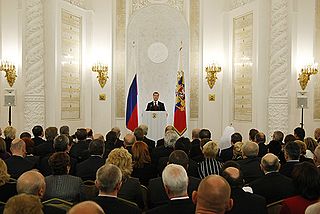
The annual Presidential Address to the Federal Assembly is a speech given by the Russian President to outline the state and condition in which Russia is in. It is given in front of a joint meeting of the two houses of the Russian Parliament: the State Duma and Federation Council. Article 84 of the current Constitution of Russia enacted in 1993 says "The President of the Russian Federation shall: address the Federal Assembly with annual messages on the situation in the country, on the guidelines of the internal and foreign policy of the State". First Russian President Boris Yeltsin delivered the first Address to the Federal Assembly on 24 February 1994. The date of the presidential address is not fixed.
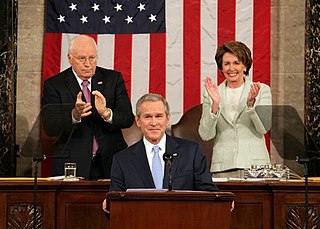
The 2007 State of the Union Address was given by the 43rd president of the United States, George W. Bush, on January 23, 2007, at 9:00 p.m. EST, in the chamber of the United States House of Representatives to the 110th United States Congress. It was Bush's sixth State of the Union Address and his seventh speech to a joint session of the United States Congress. Presiding over this joint session was the House speaker, Nancy Pelosi, accompanied by Dick Cheney, the vice president, in his capacity as the president of the Senate.
Pope Pius XII's 1942 Christmas address was a speech delivered by Pope Pius XII over Vatican Radio on Christmas 1942. It is notable for its denunciation of the extermination of people on the basis of race, and followed the commencement of the Nazi Final Solution program to exterminate the Jews of Europe. The significance of the denunciation is a matter of scholarly debate.

The 1994 State of the Union Address was given by the 42nd president of the United States, Bill Clinton, on January 25, 1994, at 9:00 p.m. EST, in the chamber of the United States House of Representatives to the 103rd United States Congress. It was Clinton's first State of the Union Address and his second speech to a joint session of the United States Congress. Presiding over this joint session was House speaker Tom Foley, accompanied by Vice President Al Gore, in his capacity as the president of the Senate.
The 1992 State of the Union Address was given by the 41st president of the United States, George H. W. Bush, on January 28, 1992, at 9:00 p.m. EST, in the chamber of the United States House of Representatives to the 102nd United States Congress. It was Bush's third and final State of the Union Address and his fourth and final speech to a joint session of the United States Congress. Presiding over this joint session was the House speaker, Tom Foley, accompanied by Dan Quayle, the vice president, in his capacity as the president of the Senate.
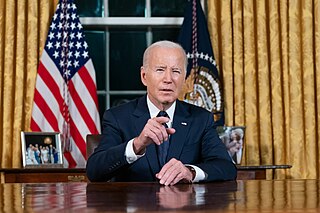
An Oval Office address is a type of speech made by the president of the United States, usually in the Oval Office at the White House. It is considered among the most solemn settings for an address made by a leader, and is most often delivered to announce a major new policy initiative, on the occasion of a leader's departure from office, or during times of national emergency.

The 1986 State of the Union Address was given by the 40th president of the United States, Ronald Reagan, on February 4, 1986, at 9:00 p.m. EST, in the chamber of the United States House of Representatives to the 99th United States Congress. It was Reagan's fifth State of the Union Address and his sixth speech to a joint session of the United States Congress. Presiding over this joint session was the House speaker, Tip O'Neill, accompanied by George H. W. Bush, the vice president.
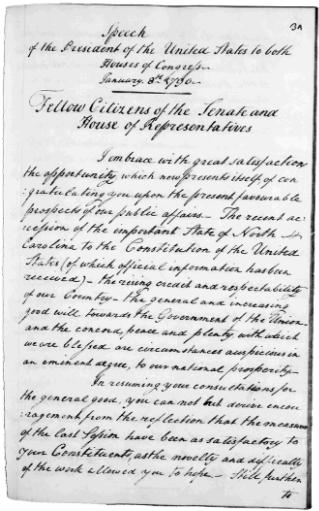
The 1790 State of the Union Address was the inaugural State of the Union address, delivered by President George Washington to the United States Congress on January 8, 1790, at the Senate Chamber of Federal Hall in New York City.
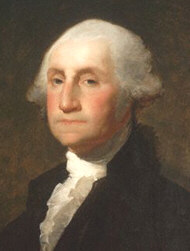
The state of union is an address, in the United States, given by the president to a joint session of Congress, the United States House of Representatives and United States Senate. The United States constitution requires the president "from time to time give to the Congress Information of the State of the Union." Today the state of the union address is given as a speech, though this is not a requirement of the constitution. George Washington chose to address the congress in a speech annually; on October 25, 1791 he gave his third speech.
The 1955 State of the Union Address was given by the 34th president of the United States, Dwight D. Eisenhower, on Thursday, January 6, 1955, to the 84th United States Congress. He said, "Every citizen wants to give full expression to his God-given talents and abilities and to have the recognition and respect accorded under our religious and political traditions." He also said, "To protect our nations and our peoples from the catastrophe of a "nuclear holocaust", free nations must maintain countervailing military power to persuade the Communists of the futility of seeking their ends through aggression." He is referring to what seemed to be the high likelihood of nuclear warfare of the time. He ended with, "And so, I know with all my heart--and I deeply believe that all Americans know--that, despite the anxieties of this divided world, our faith, and the cause in which we all believe, will surely prevail." This address was given in his first term (1953-1957), in Washington, D.C.
The 1956 State of the Union Address was delivered by Dwight D. Eisenhower, the 34th president of the United States, on Friday, January 5, 1956, to both houses of the 84th United States Congress in written format. Eisenhower did not deliver a speech before a joint session of Congress because he had suffered a major heart attack four months prior and was recovering in Key West, Florida. Instead, Eisenhower opted to pre-record remarks from his office at the Naval Air Station in Key West summarizing his State of the Union Address which were broadcast to the nation in the evening on January 5.

The 1913 State of the Union Address was given by Woodrow Wilson, the 28th president of the United States, on Tuesday, December 2, 1913. It was given directly to the 63rd United States Congress by the president as a speech. Wilson was the first to deliver it as a speech, rather than a written message, since John Adams in 1800. With a few exceptions all addresses since then have been given directly following Wilson's lead.
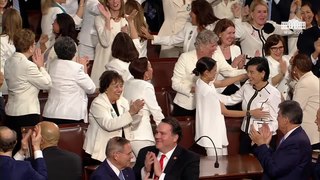
The 2019 State of the Union Address was given by the 45th president of the United States, Donald Trump, on February 5, 2019, at 9:00 p.m. EST, in the chamber of the United States House of Representatives to the 116th United States Congress. It was Trump's second State of the Union Address and his third speech to a joint session of the United States Congress. Presiding over this joint session was the House speaker, Nancy Pelosi, accompanied by Mike Pence, the vice president, in his capacity as the president of the Senate.
The following is a timeline of the presidency of Bill Clinton, from January 1, 1996, to December 31, 1996.
A royal address is a public speech by a monarch or member of a royal family. This may refer to:

The 2022 State of the Union Address was given by the 46th president of the United States, Joe Biden, on March 1, 2022, at 9:00 p.m. EST, in the chamber of the United States House of Representatives to the 117th United States Congress. It was Biden's first State of the Union Address and his second speech to a joint session of the United States Congress. Presiding over this joint session was the House speaker, Nancy Pelosi, accompanied by Kamala Harris, the vice president, in her capacity as the president of the Senate.